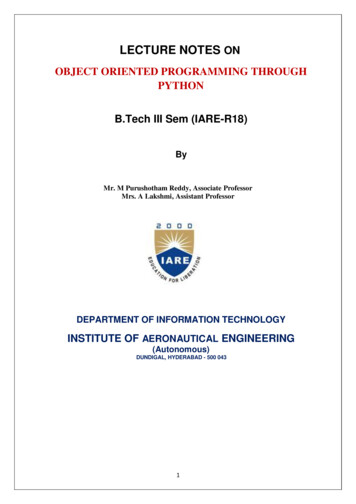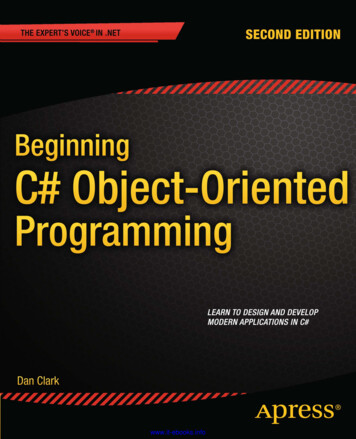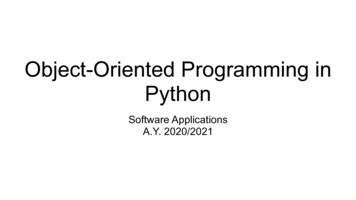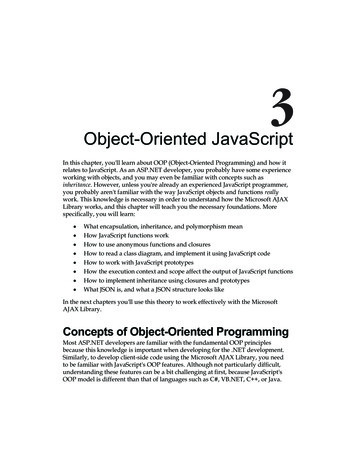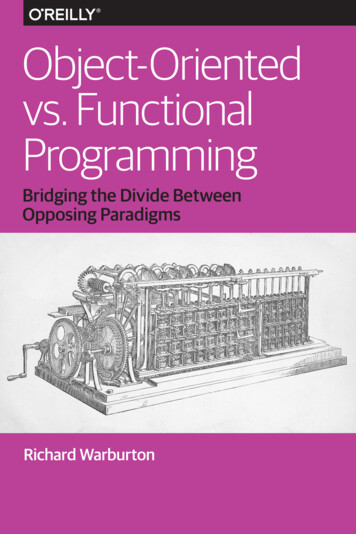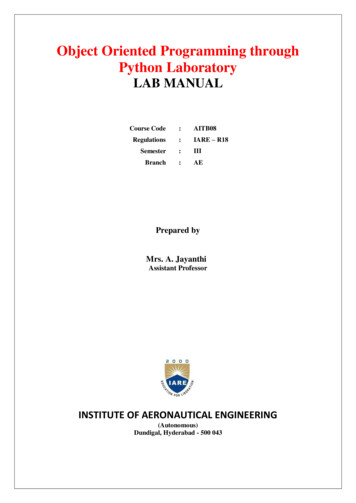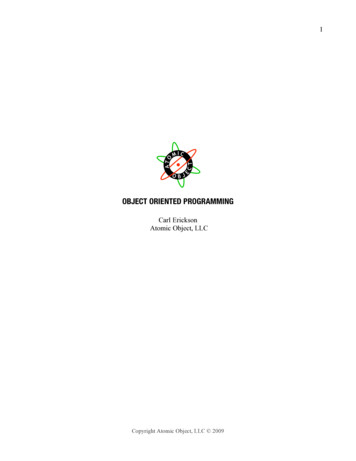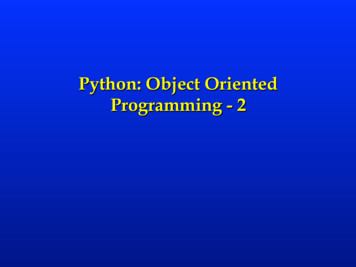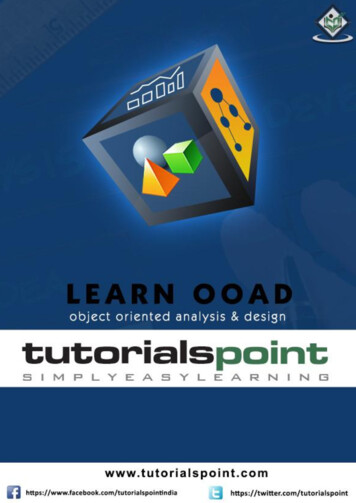
Transcription
Object-Oriented Analysis & Designi
Object-Oriented Analysis & DesignAbout the TutorialThis tutorial will help you understand the basics of object-oriented analysis and designalong with its associated terminologies.AudienceThis tutorial has been designed to help beginners. After completing this tutorial, you willfind yourself at a moderate level of expertise from where you can take yourself to nextlevels.PrerequisitesBefore you start proceeding with this tutorial, it is assumed that you have basicunderstanding of computer programming and related programming paradigms.Copyright & Disclaimer Copyright 2014 by Tutorials Point (I) Pvt. Ltd.All the content and graphics published in this e-book are the property of Tutorials Point(I) Pvt. Ltd. The user of this e-book is prohibited to reuse, retain, copy, distribute orrepublish any contents or a part of contents of this e-book in any manner without writtenconsent of the publisher.We strive to update the contents of our website and tutorials as timely and as preciselyas possible, however, the contents may contain inaccuracies or errors. Tutorials Point (I)Pvt. Ltd. provides no guarantee regarding the accuracy, timeliness or completeness ofour website or its contents including this tutorial. If you discover any errors on ourwebsite or in this tutorial, please notify us at contact@tutorialspoint.comi
Object-Oriented Analysis & DesignTable of ContentsAbout the Tutorial .iAudience .iPrerequisites .iCopyright & Disclaimer .iTable of Contents .ii1.OOAD OBJECT-ORIENTED PARADIGM . 1A Brief History .1Object-Oriented Analysis .1Object-Oriented Design .2Object-Oriented Programming .22.OOAD OBJECT MODEL . 3Objects and Classes .3Encapsulation and Data Hiding .4Message Passing .4Inheritance .5Polymorphism .6Generalization and Specialization .7Links and Association .7Aggregation or Composition.8Benefits of Object Model .83.OOAD OBJECT-ORIENTED SYSTEM . 10Phases in Object-Oriented Software Development .104.OOAD OBJECT-ORIENTED PRINCIPLES . 12ii
Object-Oriented Analysis & DesignPrinciples of Object-Oriented Systems .12Abstraction .12Encapsulation .12Modularity .13Hierarchy.13Typing .13Concurrency .13Persistence .145.OOAD OBJECT-ORIENTED ANALYSIS . 15Object Modelling.15Dynamic Modelling .15Functional Modelling .16Structured Analysis vs. Object-Oriented Analysis .16Advantages/Disadvantages of Object-Oriented Analysis .16Advantages/Disadvantages of Structured Analysis .176.OOAD DYNAMIC MODELLING . 18States and State Transitions .18Events .19Actions .20Diagrams for Dynamic Modelling .21Concurrency of Events .217.OOAD FUNCTIONAL MODELLING. 23Data Flow Diagrams .23Features of a DFD .23Developing the DFD Model of a System .27Advantages and Disadvantages of DFD .29iii
Object-Oriented Analysis & DesignRelationship between Object, Dynamic, and Functional Models .308.OOAD UML ANALYSIS MODEL. 31Brief History .31Systems and Models in UML .31Conceptual Model of UML.319.OOAD UML BASIC NOTATIONS . 34Class .34Object .34Component .35Interface.35Package .36Relationship .3610. OOAD UML STRUCTURED DIAGRAMS . 37Class Diagram .37Object Diagram .39Component Diagram .39Deployment Diagram .4011. OOAD UML BEHAVIORAL DIAGRAMS. 42Use Case Model.42Use Case Diagrams .42Interaction Diagrams .43Sequence Diagrams .44Collaboration Diagrams .44State–Chart Diagrams .45Activity Diagrams .46iv
Object-Oriented Analysis & Design12. OOAD OBJECT-ORIENTED DESIGN . 47System Design .47Object-Oriented Decomposition .47Identifying Concurrency .48Identifying Patterns.48Controlling Events .48Handling Boundary Conditions .49Object Design .49Implementation of Control.51Packaging Classes .51Design Optimization .52Design Documentation .5313. OOAD IMPLEMENTATION STRATEGIES . 55Implementation using Programming Languages .55Implementing Associations .55Implementing Constraints .60Implementing State Charts .61Object Mapping to Database System .62Mapping Associations to Database Tables .63Mapping Inheritance to Tables .6514. OOAD TESTING AND QUALITY ASSURANCE. 66Testing Object-Oriented Systems .66Object-Oriented Testing Techniques .66Software Quality Assurance .67v
Object-Oriented Analysis & DesignObject-Oriented Metrics .68vi
Object-Oriented Analysis & Design1. OOAD Object-Oriented ParadigmA Brief HistoryThe object-oriented paradigm took its shape from the initial concept of a newprogramming approach, while the interest in design and analysis methods came muchlater. The first object–oriented language was Simula (Simulation of real systems) thatwas developed in 1960 by researchers at the Norwegian Computing Center. In 1970, Alan Kay and his research group at Xerox PARK created a personalcomputer named Dynabook and the first pure object-oriented programminglanguage (OOPL) - Smalltalk, for programming the Dynabook. In the 1980s, Grady Booch published a paper titled Object Oriented Design thatmainly presented a design for the programming language, Ada. In the ensuingeditions, he extended his ideas to a complete object–oriented design method. In the 1990s, Coad incorporated behavioral ideas to object-oriented methods.The other significant innovations were Object Modelling Techniques (OMT) by JamesRumbaugh and Object-Oriented Software Engineering (OOSE) by Ivar Jacobson.Object-Oriented AnalysisObject–Oriented Analysis (OOA) is the procedure of identifying software engineeringrequirements and developing software specifications in terms of a software system’sobject model, which comprises of interacting objects.The main difference between object-oriented analysis and other forms of analysis is thatin object-oriented approach, requirements are organized around objects, which integrateboth data and functions. They are modelled after real-world objects that the systeminteracts with. In traditional analysis methodologies, the two aspects - functions anddata - are considered separately.Grady Booch has defined OOA as, “Object-oriented analysis is a method of analysis thatexamines requirements from the perspective of the classes and objects found in thevocabulary of the problem domain”.The primary tasks in object-oriented analysis (OOA) are: Identifying objects Organizing the objects by creating object model diagram Defining the internals of the objects, or object attributes Defining the behavior of the objects, i.e., object actions Describing how the objects interactThe common models used in OOA are use cases and object models.1
Object-Oriented Analysis & DesignObject-Oriented DesignObject–Oriented Design (OOD) involves implementation of the conceptual modelproduced during object-oriented analysis. In OOD, concepts in the analysis model, whichare technology independent, are mapped onto implementing classes, constraints areidentified and interfaces are designed, resulting in a model for the solution domain, i.e.,a detailed description of how the system is to be built on concrete technologies.The implementation details generally include: Restructuring the class data (if necessary), Implementation of methods, i.e., internal data structures and algorithms, Implementation of control, and Implementation of associations.Grady Booch has defined object-oriented design as “a method of design encompassingthe process of object-oriented decomposition and a notation for depicting both logicaland physical as well as static and dynamic models of the system under design”.Object-Oriented ProgrammingObject-oriented programming (OOP) is a programming paradigm based upon objects(having both data and methods) that aims to incorporate the advantages of modularityand reusability. Objects, which are usually instances of classes, are used to interact withone another to design applications and computer programs.The important features of object–oriented programming are: Bottom–up approach in program design Programs organized around objects, grouped in classes Focus on data with methods to operate upon object’s data Interaction between objects through functions Reusability of design through creation of new classes by adding features toexisting classesSome examples of object-oriented programming languages are C , Java, Smalltalk,Delphi, C#, Perl, Python, Ruby, and PHP.Grady Booch has defined object–oriented programming as “a method of implementationin which programs are organized as cooperative collections of objects, each of whichrepresents an instance of some class, and whose classes are all members of a hierarchyof classes united via inheritance relationships”.2
Object-Oriented Analysis & Design2. OOAD Object ModelThe object model visualizes the elements in a software application in terms of objects. Inthis chapter, we will look into the basic concepts and terminologies of object–orientedsystems.Objects and ClassesThe concepts of objects and classes are intrinsically linked with each other and form thefoundation of object–oriented paradigm.ObjectAn object is a real-world element in an object–oriented environment that may have aphysical or a conceptual existence. Each object has: Identity that distinguishes it from other objects in the system. State that determines the characteristic properties of an object as well as thevalues of the properties that the object holds. Behavior that represents externally visible activities performed by an object interms of changes in its state.Objects can be modelled according to the needs of the application. An object may have aphysical existence, like a customer, a car, etc.; or an intangible conceptual existence,like a project, a process, etc.ClassA class represents a collection of objects having same characteristic properties thatexhibit common behavior. It gives the blueprint or description of the objects that can becreated from it. Creation of an object as a member of a class is called instantiation.Thus, object is an instance of a class.The constituents of a class are: A set of attributes for the objects that are to be instantiated from the class.Generally, different objects of a class have some difference in the values of theattributes. Attributes are often referred as class data. A set of operations that portray the behavior of the objects of the class.Operations are also referred as functions or methods.ExampleLet us consider a simple class, Circle, that represents the geometrical figure circle in atwo–dimensional space. The attributes of this class can be identified as follows: x–coord, to denote x–coordinate of the center y–coord, to denote y–coordinate of the center a, to denote the radius of the circle3
Object-Oriented Analysis & DesignSome of its operations can be defined as follows: findArea(), method to calculate area findCircumference(), method to calculate circumference scale(), method to increase or decrease the radiusDuring instantiation, values are assigned for at least some of the attributes. If we createan object my circle, we can assign values like x-coord : 2, y-coord : 3, and a : 4 todepict its state. Now, if the operation scale() is performed on my circle with a scalingfactor of 2, the value of the variable a will become 8. This operation brings a change inthe state of my circle, i.e., the object has exhibited certain behavior.Encapsulation and Data HidingEncapsulationEncapsulation is the process of binding both attributes and methods together within aclass. Through encapsulation, the internal details of a class can be hidden from outside.It permits the elements of the class to be accessed from outside only through theinterface provided by the class.Data HidingTypically, a class is designed such that its data (attributes) can be accessed only by itsclass methods and insulated from direct outside access. This process of insulating anobject’s data is called data hiding or information hiding.ExampleIn the class Circle, data hiding can be incorporated by making attributes invisible fromoutside the class and adding two more methods to the class for accessing class data,namely: setValues(), method to assign values to x-coord, y-coord, and a getValues(), method to retrieve values of x-coord, y-coord, and aHere the private data of the object my circle cannot be accessed directly by any methodthat is not encapsulated within the class Circle. It should instead be accessed throughthe methods setValues() and getValues().Message PassingAny application requires a number of objects interacting in a harmonious manner.Objects in a system may communicate with each other using message passing. Supposea system has two objects: obj1 and obj2. The object obj1 sends a message to objectobj2, if obj1 wants obj2 to execute one of its methods.The features of message passing are: Message passing between two objects is generally unidirectional. Message passing enables all interactions between objects. Message passing essentially involves invoking class methods.4
Object-Oriented Analysis & Design Objects in different processes can be involved in message passing.InheritanceInheritance is the mechanism that permits new classes to be created out of existingclasses by extending and refining its capabilities. The existing classes are called the baseclasses/parent classes/super-classes, and the new classes are called the derivedclasses/child classes/subclasses. The subclass can inherit or derive the attributes andmethods of the super-class(es) provided that the super-class allows so. Besides, thesubclass may add its own attributes and methods and may modify any of the super-classmethods. Inheritance defines an “is – a” relationship.ExampleFrom a class Mammal, a number of classes can be derived such as Human, Cat, Dog,Cow, etc. Humans, cats, dogs, and cows all have the distinct characteristics ofmammals. In addition, each has its own particular characteristics. It can be said that acow “is – a” mammal.Types of Inheritance Single Inheritance : A subclass derives from a single super-class. Multiple Inheritance : A subclass derives from more than one super-classes. Multilevel Inheritance : A subclass derives from a super-class which in turn isderived from another class and so on. Hierarchical Inheritance : A class has a number of subclasses each of whichmay have subsequent subclasses, continuing for a number of levels, so as toform a tree structure. Hybrid Inheritance : A combination of multiple and multilevel inheritance so asto form a lattice structure.The following figure depicts the examples of different types of inheritance.5
Object-Oriented Analysis & DesignPolymorphismPolymorphism is originally a Greek word that means the ability to take multiple forms. Inobject-oriented paradigm, polymorphism implies using operations in different ways,depending upon the instance they are operating upon. Polymorphism allows objects withdifferent internal structures to have a common external interface. Polymorphism isparticularly effective while implementing inheritance.Example6
Object-Oriented Analysis & DesignLet us consider two classes, Circle and Square, each with a method findArea(). Thoughthe name and purpose of the methods in the classes are same, the internalimplementation, i.e., the procedure of calculating area is different for each class. Whenan object of class Circle invokes its findArea() method, the operation finds the area ofthe circle without any conflict with the findArea() method of the Square class.Generalization and SpecializationGeneralization and specialization represent a hierarchy of relationships between classes,where subclasses inherit from super-classes.GeneralizationIn the generalization process, the common characteristics of classes are combined toform a class in a higher level of hierarchy, i.e., subclasses are combined to form ageneralized super-class. It represents an “is – a – kind – of” relationship. For example,“car is a kind of land vehicle”, or “ship is a kind of water vehicle”.SpecializationSpecialization is the reverse process of generalization. Here, the distinguishing featuresof groups of objects are used to form specialized classes from existing classes. It can besaid that the subclasses are the specialized versions of the super-class.The following figure shows an example of generalization and specialization.Links and AssociationLinkA link represents a connection through which an object collaborates with other objects.Rumbaugh has defined it as “a physical or conceptual connection between objects”.Through a link, one object may invoke the methods or navigate through another object.A link depicts the relationship between two or more objects.Association7
Object-Oriented Analysis & DesignAssociation is a group of links having common structure and common behavior.Association depicts the relationship between objects of one or more classes. A link canbe defined as an instance of an association.Degree of an AssociationDegree of an association denotes the number of classes involved in a connection. Degreemay be unary, binary, or ternary. A unary relationship connects objects of the same class. A binary relationship connects objects of two classes. A ternary relationship connects objects of three or more classes.Cardinality Ratios of AssociationsCardinality of a binary association denotes the number of instances participating in anassociation. There are three types of cardinality ratios, namely: One–to–One : A single object of class A is associated with a single object of class B. One–to–Many : A single object of class A is associated with many objects of class B. Many–to–Many : An object of class A may be associated with many objects of classB and conversely an object of class B may be associated with many objects of class A.Aggregation or CompositionAggregation or composition is a relationship among classes by which a class can bemade up of any combination of objects of other classes. It allows objects to be placeddirectly within the body of other classes. Aggregation is referred as a “part–of” or “has–a” relationship, with the ability to navigate from the whole to its parts. An aggregateobject is an object that is composed of one or more other objects.ExampleIn the relationship, “a car has–a motor”, car is the whole object or the aggregate, andthe motor is a “part–of” the car. Aggregation may denote: Physical containment : Example, a computer is composed of monitor, CPU,mouse, keyboard, and so on. Conceptual containment : Example, shareholder has–a share.Benefits of Object ModelNow that we have gone through the core concepts pertaining to object orientation, itwould be worthwhile to note the advantages that this model has to offer.The benefits o
Delphi, C#, Perl, Python, Ruby, and PHP. Grady Booch has defined object–oriented programming as “a method of implementation in which programs are organized as cooperative collections of objects, each of which represents an instance of som
